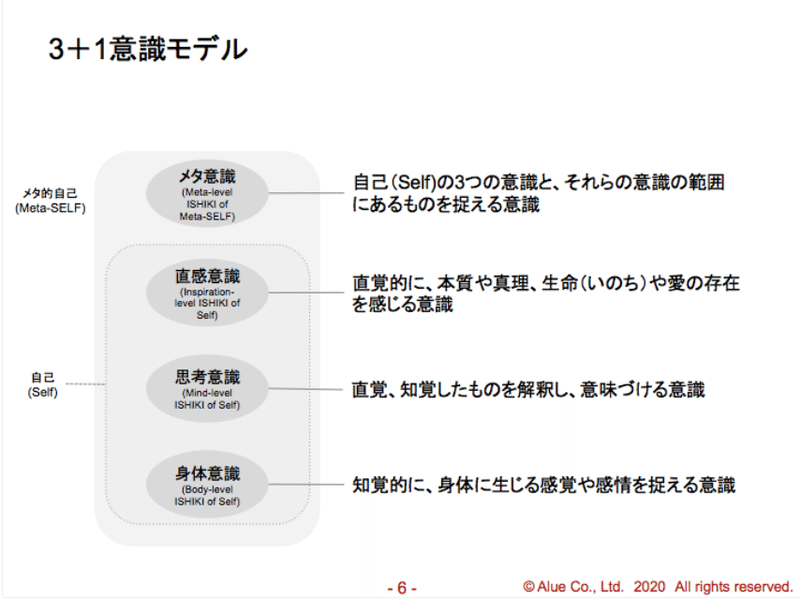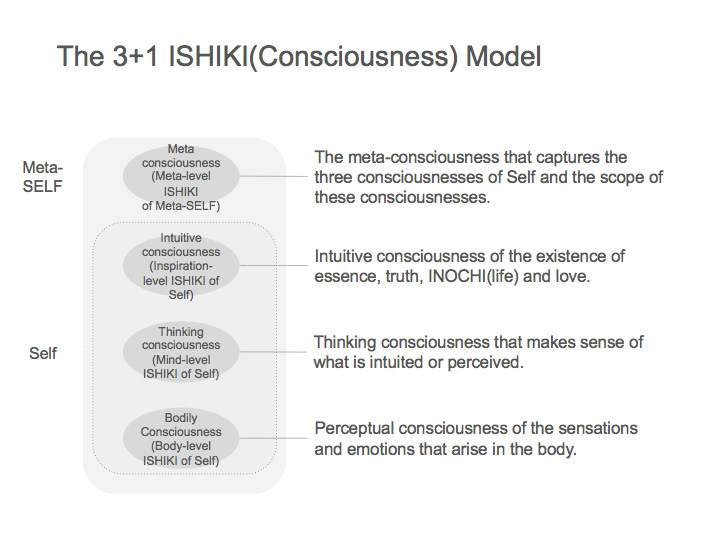
自分への信頼は、どのように生み出せるか?
前回の記事では、自己信頼とは自分を無条件で信じることであり、それは「ありのままの自分を捉える」という自己一致の積み重ねによって培われるということをお話ししました。
今回は、自己信頼を生み出すメカニズムについて3+1意識モデルを活用して説明したいと思います。
3つの意識の全てにおいて「ありのままの自分」を捉える
「ありのままの自分を捉える」上でポイントになるのが、意識の意識化です。ここでも、何回か登場している3+1意識モデルが役に立ちます。

3+1意識モデルでは、特定の意識領域に偏ることなく、すべての意識領域を意識化することが「ありのままの自分を捉える」ことにつながると考えます。
学歴や職歴、現在の肩書きや他人からの評価といったものは、具体的な事実を元にして、何らかの基準をもとに評価しているものという意味で、自分を思考意識から捉えたものと言えます。
一方で、自分のありたい姿や、心の底から願っていることや主体的真理といったものは、直感的に持っている意思のようなもので、自分を直感意識から捉えたものと言えます。
▼順調に出世しているが、何か満たされない想いがある。
▼猛烈に仕事をしていないと、不安になる。
▼自分に対するポジティブなコメントや評価をもらい続けていないと不安になる。
▼何らかの評価や肩書きを得たことで満足し、自分の仕事の価値や意義に無頓着になる。
こうした例はすべて、思考意識に偏重し、直感意識とのつながりが薄れている状態です。肩書きや他人からの評価ばかりに捉われて本当に自分のやりたいことを無視していると、「ありのままの自分」から遠ざかっていきます。
一方で、思考意識を無視していいわけではありません。自分が考えていることや、その前提となる価値観を否定したり、無視したりする必要もありません。「そのように考えている自分もいるんだな」と受け止めてあげることが大切です。思考意識を軽視するのも、「ありのままの自分」から遠ざかることになります。
感情や身体感覚や行動を司る身体意識を捉えることも大切です。
心臓の鼓動や汗が出るなどの感覚や、様々な感情から、いま自分がどう感じているかを知ることができます。緊張や怒り、不安や悲しみ、あるいは安心感、リラックスした感覚など、自分の感覚から得られるものはたくさんあります。
▼会議での上司の発言に何となく違和感を覚えたが、論理的には整合性がとれているので、特段気に留めなかった
▼目の前にあるチャンスを掴んだ方がいいと直感したので、心の奥底にある不安感を押さえ込んで、なるべく無視するようにした
これらの身体感覚や感情を無視して、論理的な正しさ(思考意識)や、降りてくる直感のみに偏重すると、自分らしくない意思決定をしてしまうことがあります。身体意識は、「ほんとうの自分」が感じていることを知るための重要なヒントを与えてくれると言ってもいいでしょう。
また、身体意識は行動を司ります。頭で色々と思い悩むことにとどまり、行動に移すことができないということは誰しも経験があるのではないでしょうか。頭ではわかっているのに、行動に移すことができないというときは、身体感覚を適切に捉えられていないことが多いです。例えば、恐れや不安などの感情があるにも関わらず、それを捉えられていないので、自分の中に無意識の抵抗が起こり、行動に移せないということがあります。

メタ意識を活用して、自己一致する
ここまで、3つの意識(特に、直感意識と身体意識)を捉えることができていないことについて述べましたが、何が難しいのかと言えば、たいていの場合、無意識にそうなってしまうことです。
直感意識からのメッセージに気付けずに悶々と悩む人も、身体意識で感じていることに目を向けられない人も、それをわざと無視しているというよりも、認識できていないという場合が多いでしょう。
だからこそ、意識の意識化が重要なのです。直感、思考、身体意識をありのままに捉えてみる。3つの意識のどこかに偏重していたり、3つの意識が捉えていることを無視していたりしないか、意識的にチェックするのです。
ここからは、具体的にどのようにすればいいかについて、3+1意識モデルを用いながらご説明します。3つの意識を偏重することなく捉えるためには、メタ意識を活用します。
メタ意識とは、「自己の3つの意識と、それらの意識の範囲にあるものを捉える意識」と定義していますが、平たく言えば「自分を捉える、もう1人の自分」ということです。
メタ意識の具体的イメージについては、人によって違いますが、私の場合は、自分の頭上からみているもう1人の自分のイメージとなります。メタ意識から自分を見ると、自分の頭や背中が見えている感じになります。
最近は、オンライン会議において、自分を含めた参加者の顔が一覧で表示されることが多いですが、それを見ている自分(会議に参加している自分を見ている自分)もメタ意識に近いと感じます。
あるいは、身の回りのもので、「自分をよく表してると思うもの」を思い浮かべて見てください。それは、パソコンであったり、ノートであったり、楽器であったり、スポーツの道具だったりするでしょう。その物を自分と見立てた時に、物を見ている自分はメタ意識に近いと言えるでしょう。

このメタ意識から、直感、思考、身体意識をありのままに捉えることができている状態を「自己一致」といいます。
自己一致の定義(落合の考え)
メタ意識から、直感、思考、身体意識をありのままに捉えること
ありのままに捉えるというのは、評価や判断をすることなく、なるべくそのままの状態を感じとるということです。一般的に望ましいとされることではない直感や思考や感情であっても、「それはダメだ」などと判断する必要はありません。「ああ、そういう直感・思考・感情があるんだなー」とそのまま受容するイメージです。
また、思考意識で捉えていることと、身体意識で捉えていることが矛盾するということもあります。頭で考えていることと、心の中で感じていることが違うということを経験したことがある人も多いのではないでしょうか。このような場合でも、矛盾していることは良くない、などと判断する必要はありません。「ああ、いろいろな思いや感情が自分の中にあるんだなー」と捉えるイメージです。
自己一致は、安心感・安定感をもたらす
このようにメタ意識を活性化して、直感・思考・身体の3つの意識それぞれをありのままに捉えているときに、「メタ意識にいるときの自分の感覚はどのようなものか」ということを問いかけてみることをお薦めします。
人によって表現される内容は異なりますが、私の場合は「安心感・安定感」のようなイメージの感覚を持ちます。安心感というのは、どんな不安やどんな恐れがある場面でも、そのような自分を見守っているメタ意識にいる自分が存在している安心感というイメージです。安定感というのは、それがいつでもどこでも常に感じようと思えば、感じられるということです。
1つ私の事例をお話ししましょう。2020年のパンデミックによって、当社(アルー株式会社)の研修事業は大きな打撃を受けました。研修は、いわゆる三密業態の1つであり、それが当社の繁忙期である4月・5月に重なったため、キャンセルが相次ぎ、その顧客対応、オンライン化への対応、売上減少に伴うコスト構造や体制の見直しなど、様々なことに全社で対応する必要に迫られました。
そのような環境にあっても、経営者である私は前向きに考え、振る舞う必要があると考え、極力弱音を吐かずに、明るくコミュニケーションをして、前向きなヴィジョンを示そうと思い、日々奮闘していました。
しかし、心の中では不安な気持ちがあったことも否めません。例えるならば、自分がエレベーターの中にいて、巨大がゴジラがそのエレベーターを揺すっている感じを持っていました。自分ではコントロールできない、何か大きなものに運命を握られて、右に左に心と体が動かされている感じです。
そのときに、メタ意識から自分をありのままに捉えることを日々実践するようにしました。最初は瞑想のように目をつぶって、自分の上から自分を見つめている視点で、3つの意識それぞれを捉えてようとすることから始めましたが、慣れてくると瞑想をしていなくても、メタ意識が活性化して、直感・思考・身体意識につながるような感覚をもつことができます。
そのような実践をする中で、ある1つのメタファーが思いつきます。それは映画俳優と映画監督というメタファーです。映画俳優というのは、自分の人生ストーリーを生きている主人公としての自分です。そして、映画監督というのは、自分の人生ストーリーがいい形で具現化することを見守っている自分です。

3+1意識モデルとの関係でいえば、映画俳優は直感・思考・身体意識をもつ自分であり、映画監督はメタ意識をもつ自分です。
先ほどの私の事例でいえば、パンデミックという外部環境に大きく負の影響を受けていたのは映画俳優としての私でした。その場面においては、逆境に負けそうになる映画の主人公のように日々苦労をして、日々悩んでいます。しかし、それを舞台の外から見守っている映画監督としての自分がいることに気づきます。その映画監督は、コーヒーをすすりながら、「うん、なかなかの名演技だ」とかいいながら、ゆったりと構えています。
そのようなメタファーで自分を捉えた時に、ふっと心が軽くなったことを昨日のことのように覚えています。「そうか、これは自分の人生ストーリー、として、アルー株式会社の会社ストーリーの中で、1つの欠かせないシーンなのだろう」と。映画のストーリーには必ずと言っていいほど、主人公が逆境に陥るシーンがあります。その映画の逆境シーンと同じだなと思えれば、そんなに思い悩む必要もありません。その逆境シーンでの主人公を演じきるのみです。
このような逆境のシーンだけではなく、常に、映画俳優としての視点と、映画監督としての視点の両方を持ち続けることができたら、どうでしょうか。映画俳優として、目の前の事象における喜怒哀楽を感じながら、一方で映画監督としての落ち着き・安心感・安定感でそれを見守ることができている。

そのようなことが、いつでもどこでも感じられるという確信になっていったときに、自己信頼に近づいているということをご理解いただけるのではないかと思います。
本日の問いとなります。(よろしければ、コメントにご意見ください)
・身の回りのもので、「自分をよく表してると思うもの」を思い浮かべて見てください。それを「最近の自分」として見立てた時に、どのような声をかけてあげたいですか?
・上記において、メタ意識にいるときの自分の感覚はどのようなものですか?
・映画俳優としての視点と、映画監督としての視点の両方を持ち続けることができたら、あなたにとってどのようないいことがありそうでしょうか?
How can we create trust in ourselves?
In my previous article, I mentioned that self-trust is unconditional reliance on oneself, and that it is cultivated through the accumulation of self-congruence in "perceiving oneself as one is."
In this article, I would like to explain the mechanism that creates self-trust, utilizing the 3+1 Consciousness Model.
Perceive oneself as one is, in all three levels of consciousness
The key to "seeing ourselves as we are" is to manage our consciousness. This is where the 3+1 Consciousness Model, which has appeared several times, comes into play.

In the 3+1 Consciousness Model, I believe that becoming aware of all areas of consciousness, without being biased toward any particular area, leads to "perceiving ourselves as we are."
Education, work history, current title, and evaluations from others are all based on concrete facts, and evaluated based on some kind of criteria, which means that they are perceived from our thinking consciousness.
On the other hand, what we want to be, what we wish from the bottom of our heart, and subjective truths are like intuitive intentions that we have, and we can say that they are perceived from our intuitive consciousness.
▼ "Although I am making steady progress in my career, I feel unfulfilled."
▼ "I feel anxious when I am not working intensely."
▼ "If I don't continue to receive positive comments and evaluations about myself, I feel anxious."
▼Satisfied with having received some sort of recognition or title, one becomes indifferent to the value and significance of one's work.
These are all examples of a state of mind that is overly focused on thinking consciousness and less connected to intuitive consciousness. If we ignore what we really want to do and focus only on our titles and what others think of us, we will move away from who we really are.
On the other hand, it does not mean that we can ignore our thinking consciousness. There is no need to deny or ignore what we are thinking or the values that underlie it. It is important to accept that there is a part of us that thinks that way. Neglecting our thinking consciousness is also a way to move away from who we really are.
It is also important to perceive the bodily consciousness that manages emotions, physical sensations and actions.
We can get an idea of how we are feeling right now from sensations such as a beating heart or sweating, or from various emotions. Tension, anger, anxiety, sadness, or a sense of relief and relaxation are some of the many things we can get from our senses.
▼ I felt somewhat uncomfortable with what my boss said at the meeting, but since it was logically consistent, I didn't pay any particular attention to it.
▼ I had a gut feeling that it would be better to seize the opportunity in front of me, so I suppressed the feeling of anxiety deep inside me and tried to ignore it as much as possible.
If we ignore these bodily sensations and feelings and focus only on logical rightness (thinking consciousness) or intuition that comes down to us, we may end up making decisions that are not like us. It is fair to say that bodily awareness gives us important clues to know what our "true self" is feeling.
Also, bodily awareness influences action. We all have experienced the situation where we only think about things in our head and cannot put them into action. When we know what we want to do in our head, but can't put it into action, it is often because we don't understand our physical sensations properly. For example, we may have emotions such as fear or anxiety, but because we are not able to perceive them, unconscious resistance occurs within us and we are unable to take action.
Utilize meta-consciousness to become self-congruent
I have mentioned that we often fail to perceive the three consciousnesses (especially the intuitive and bodily consciousnesses), but what is difficult is that most of the time, we do so unconsciously.
Whether a person is agonizing over not being able to recognize a message from their intuitive consciousness, or not being able to pay attention to what they are feeling in their bodily consciousness, it is often the case that they are not recognizing it, rather than deliberately ignoring it.
That's why it's so important to become aware of our consciousness. Try to perceive our intuition, our thinking, and our bodily consciousness as they are, consciously checking to see whether we are biased toward any of the three consciousnesses, or whether we are ignoring what all three are perceiving.
The following is an explanation of how concretely we can do this, using the 3+1 Consciousness Model. In order to perceive all three consciousnesses without bias, we can use meta-consciousness.
Meta-consciousness is defined as "the consciousness that captures the three consciousnesses of Self and the scope of these consciousnesses," or in layman's terms, "the other self that captures oneself."
The specific image of meta-consciousness differs from person to person, but in my case, it is the image of another self looking over my head. When I look at myself from my meta-consciousness, I feel like I can see my head and back.
Recently, in online meetings, the faces of the participants, including myself, are often displayed in a list, and I feel that myself looking at it (myself looking at myself participating in the meeting) is also close to meta-consciousness.
Or, think of something around you that you think represents you well. It could be a computer, a notebook, a musical instrument, or a piece of sports equipment. When you think of that object as yourself, you can say that the self that is looking at the object is close to the meta-consciousness.
From this meta-consciousness, the state of being able to perceive intuition, thinking, and bodily awareness as they are is called "self-congruence."
Definition of self-congruence (Ochiai's idea):
To capture intuition, thinking, and bodily awareness as they are from meta-consciousness.
To perceive things as they are means to feel them as they are without evaluation or judgment. Even if our intuition, thinking, or feeling is not generally considered desirable, there is no need to judge it as "bad." Just accept them as they are, saying, "Oh, that's how I intuit, think, or feel."
There are also times when what we perceive in our thinking consciousness contradicts what we perceive in our bodily consciousness. Many of you may have experienced that what you think in your head is different from what you feel in your heart. Even in such cases, there is no need to judge inconsistency as a bad thing. Just think of it as, "Oh, there are so many thoughts and feelings inside of me."
Self-congruence brings a sense of relief and stability
When we activate our meta-consciousness in this way, and capture each of the three types of consciousness (intuition, thinking, and body) as they are, I recommend that we ask ourselves, "What is my feeling when I am in my meta-consciousness?"
It is expressed differently by individuals, but in my case, I have a sense of image like " relief and stability. Relief is the image of a sense of comfort in knowing that there is a meta-conscious self watching over me in any situation of anxiety or fear. A sense of stability means that it can be felt at all times and in all places, if I want to feel it.
Let me tell you about one of my own stories: the pandemic of 2020 hit our training business ( Alue Corporation) hard. Training is one of the so-called "three densities" of business, and since it coincided with our busy months of April and May, we were forced to deal with a rash of cancellations. We are forced to deal with a variety of issues, such as dealing with customers who were canceling their orders, dealing with the shift to online services, and reviewing cost structures and organizational structures in response to declining sales.
Even in such an environment, as the CEO, I thought it was necessary to think and act positively, and I struggled every day to show a positive vision by communicating cheerfully and without showing any signs of weakness.
However, I can't deny that I was feeling uneasy in my heart. To use an analogy, I felt as if I was in an elevator and a giant Godzilla was shaking the elevator. I felt as if my fate was in the hands of something big that I couldn't control, and my mind and body were being moved left and right.
At that time, I started practicing daily to perceive myself as I am from the meta-consciousness. At first, I started by closing my eyes like in meditation and trying to perceive each of the three consciousnesses from the perspective of looking at myself from above, but as I got used to it, I found that even without meditation, my meta-consciousness was activated and I could have the feeling of being connected to my intuition, thinking, and bodily consciousness.
In the process of implementing such a practice, I came up with a metaphor. It is the metaphor of the movie actor and the movie director. The film actor is the main character who is living one' s own life story. And the film director is the one who watches over one' s life story to assure that it realizes in a good way.

In relation to the 3+1 consciousness model, the film actor is the self with intuition, thinking, and bodily consciousness, and the film director is the self with meta-consciousness.
In my case mentioned earlier, it was me as a movie actor who was greatly negatively affected by the external environment of the pandemic. In that scene, like the main character in the movie who is about to be defeated by adversity, I am struggling and suffering day by day. However, I noticed myself as a film director watching over the scene from outside the stage. The film director sips his coffee and says, "Yes, that' s quite a great performance," sitting back and taking things easy.
I remember as if it were only yesterday that I felt a sudden lightness in my heart when I saw myself in such a metaphor. I thought to myself, "Well, I guess this is an essential scene in my life story, as well as in the story of Alue Corporation. In every movie story, there is a scene where the main character falls into adversity." If I can think that it is the same as the adversity scene in a movie, I don't have to worry so much about it. All I have to do is to play the role of the main character in that adversity scene.
What if we could keep both our perspectives as a film actor and as a film director at all times, not just in these scenes of adversity? As a film actor, we can feel the joy, anger, pleasure, and grief of the events in front of us, while at the same time, we can watch them with the calmness, relief, and stability of a film director.
When we become convinced that we can feel such things anytime and anywhere, you will understand that we are approaching self-trust.
Here are the quests of the day. (If you'd like, please share your thoughts in the comments.)
・Think of something around you that you think represents you well and look at it. What would you like to say to it when you see it as your "recent self"?
・In the above, what are your sensations or feelings when you are in the meta-consciousness?
・What good would come to you if you could keep both your perspective as a film actor and as a film director?
Bunshiro Ochiai
この記事が気に入ったらサポートをしてみませんか?
